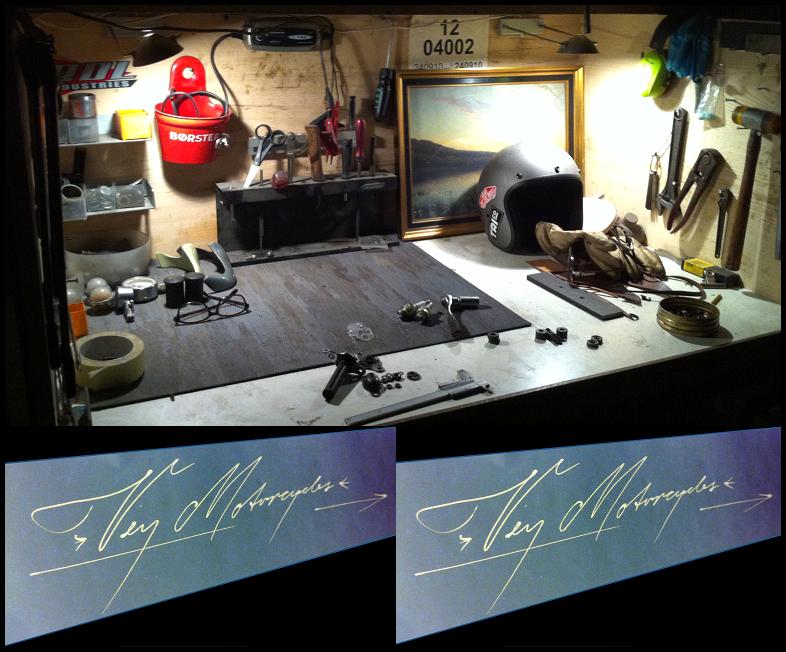Part 1: Lets get this started…
Ok, I’ve
been slumbering all autumn at the foot of the aluminium hills of wisdom…
Wizardry in metallurgical preposterous behavior of precipitate-hardening alloys
for secret societies, intercrystallic bonds of incoherent faces and the entropy
of vacancies in time space continuum often leads to a broken liver and an
aching head…
Therefore I’ll
now start showing what I promised you so long ago.. How to make yourself a neat
leather saddle, when you can’t afford to let “Heathers” make it for you…
First of
all this is what I use:
Plus this:
Peter Cook Heavy duty adhesive.
Now there
are many different approaches on this subject, but the way I like to start off
is to:
1. Strip everything
off the seat pan and if necessary give it a good sandblasting. Now you’ll know
what shape your pan is in and where to begin.
2. Decide
in which degree you want to restore your seat. You probably want to go all in
on fixing little cracks and weld stuff that needs weldning since you are not
going to want to do this when your seat is upholstered and nice… So, make sure
all holes for the rivets on the perimeter are even spaced, since they’re gonna
be visible when done. Make sure the front bracket is not broken. Make sure the
egde of the pan is not too badly bent and wavy. And that’s about it.
3. Paint
the pan, inside and outside. Inside? Why? Its not going to be visible? Well, at
some point (unless you live in always sunny SoCal) it’s going to get wet and
rusty if you don’t do it. It doesn’t have to the thickest layer inside, You
still want the glue to be able to stick, so just a thin layer will do fine.
Also If your seat is not fitted with “vent” holes in the bottom drill some, for
condensation moist not to build up under the foam.
4. Cut long
strips of thick leather (3mm – 1/8 in) to go on either side of the edge. Depending on
the distance from your rivet holes to the edge, cut strips of about 50 mm - 2
inches in width and make them as long as possible. Soak the strips in water for
about 20 min, that’ll make them tractable when you’re going to force them
around the curves. Mark up the center (lengthwise) of the strips and punch/cut
a hole about 2/3’s from the bottom edge. Start by riveting the middle of the
rear ridge on the seat, working your way towards the nose of the seat, from
both sides, making sure at all times that the leather is symmetric around the
middle. Of course this only applies if your strips aren’t long enough to reach
all around the perimeter, but still keep in mind that somewhere there’s going
to be a joint, so you might as well do it in the middle of the nose.
Riveting done, and stitching the four
pieces together on either side, symmetric around the center axis. As you’ll
notice, I’ve cut notches in the leather on the inside top of the nose, to
relief stress and make it easier to bend. The reason why I apply thick strips
of leather on both sides is that this will prevent the metal edge from working
its way through the thinner top leather and it’ll make the finished edge much
nicer.
5. Time for foam. I use cheap
sleeping pad for foam. It’s got three advantages over regular foam: One, it’s
easy to apply. Two, it’s easy to shape. Three, it doesn’t act like a sponge
when soaked after a long days ride in the rain.
Cut thin strips to glue in the little
reinforcement voids. And trim excess off. Just use Locktite super glue, it
dries up quick (10 sec) and is sh…t easy to use.
Now lay the foam on top of your seat
press it down with one hand and with the other mark with a speedmarker the very
rough outline. You want to have the foam reaching the outer edge of the leather.
Rough the surface slightly, with
some sandpaper p120-180, to give the glue a surface easy to bind to. Wipe down
with thinner or alcohol.
Apply glue on both seat and foam and
basically just follow the instructions on the can, as regarding to drying time
and so on. I’ve tested this specific glue “Peter Cook”’s ability to glue
soaking wet leather on foam, and found it excellent. This will prove to be very
useful later on.
Massage the foam from the middle of
the seat and outwards towards the perimeter, to get rid of airpockets, this is
especially important in the area marked. If you’re having trouble with the foam
not wanting to set into the curved area, cut stress relief grooves:
6. Trim and repeat: Trim roughly and
mark the outline of the second glue area => Second layer of foam. Depending
on how thick you want your padding, chose how many layers you put on. I usually
aim for around 15-20mm = 5/8 – ¾ in. Glue on the next layer the same way as
before.
Massage it down and make sure it’s
staying down! Cut grooves if necessary.
Questions are always welcome.
We’ll finish it up in the next
episode: Part 2.
The professor says: Stay safe!!!!
...until next time..
-the Professor.










